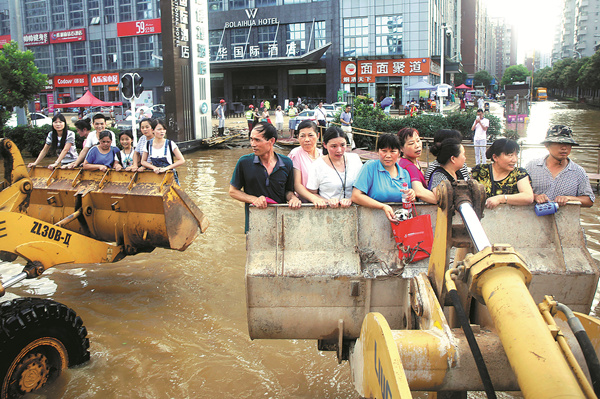Smaller rivers proving the bigger challenge
By Hou Liqiang (China Daily) Updated: 2016-07-11 04:18
 |
|
Excavators are used to transport people through the floodwaters in Wuhan, Hubei province, on Friday. [Photo/Agencies] |
Nepartak is only the first typhoon of the year, and the freak weather conditions are serving as an important lesson: Despite all the money cities have spent building high-rise towers and broad roads, they have committed far too little to protecting people's lives.
The city of Chibi in Hubei province is a case in point. Xin'gangdi used to be a little-known river on the outskirts of the historic city. Yet on July 4 this waterway gained national attention when it grew from its usual 3-meter width to a massive 50 meters after days of persistent rain.
The river broke its banks and flooded three residential areas of Shaziling village, trapping more than 800 people.
"The water reached my ankles by evening, but it rose so fast that it would have submerged me completely by the next morning if I'd stayed in the same place," said villager Zhuo Yong, who stands 1.85 meters tall.
"Compared with the trunk of major rivers, such small rivers receive much less attention — but they can kill people, too," he said.
Zhuo, 23, together with another 10 men, cut down bamboo and made four rafts. At about 5 am on July 4, they went in search of stranded villagers. By that time, he said, the first and second floors of many buildings were already submerged.
Firefighters had evacuated most people, with only one fatality. Many homes were damaged and more than 133 hectares of farmland now face total crop failure.
As this year's weather and hydrological factors closely resemble those of 1998, when floods killed about 3,000 people nationwide, the authorities have warned that China could be hit by its biggest flood for about 20 years.
According to the State Flood Control and Drought Relief Headquarters, the country has had 24 rainstorms since the beginning of the flood season this year, resulting in 321 rivers rising above safe levels.
Shaziling is one of thousands of villages and towns along smaller rivers that stand to suffer substantial losses from the floods.
Chen Min, director of the Yangtze River office of the Flood Control and Drought Relief Headquarters, said due to low flood-prevention standards, most of the 30 billion yuan ($4.4 billion) in economic losses in the Yangtze basin have been in areas along small and medium-sized rivers.
"There have been few disasters along the main stream (of the Yangtze). Most of the losses have been along its branches," he said.
Dams in some counties have failed to cope with the deluge, while those in many towns and villages have been overwhelmed, he said.
Chen said although the government has invested billions into flood controls along the smaller rivers, "It's still far from enough".
Chen Jin, vice-dean of the Yangtze River Scientific Research Institute, added that the economic losses were also due to the unscientific planning of land use in China.
Large populations and a great number of factories and other facilities are situated in areas with high flood risks, he said. "The problem can hardly be solved in the short term, as many people settled in those areas a long time ago."
Contact the writers at houliqiang@chinadaily.com.cn
Xu Wei in Beijing contributed to this story.
